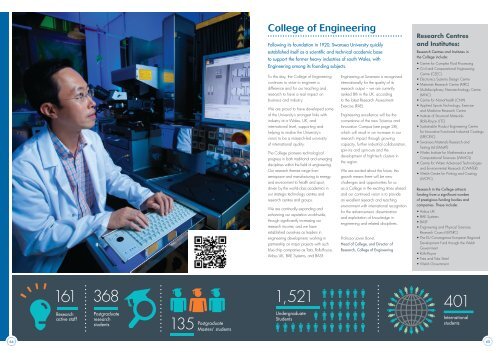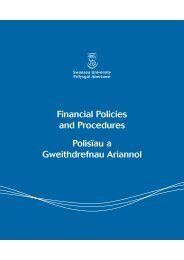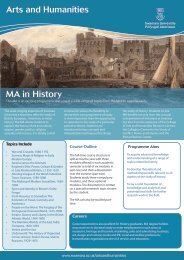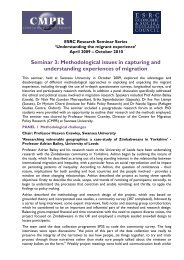College of Engineering - Swansea University
College of Engineering - Swansea University
College of Engineering - Swansea University
Create successful ePaper yourself
Turn your PDF publications into a flip-book with our unique Google optimized e-Paper software.
<strong>College</strong> <strong>of</strong> <strong>Engineering</strong><br />
Following its foundation in 1920, <strong>Swansea</strong> <strong>University</strong> quickly<br />
Research Centres<br />
and Institutes:<br />
established itself as a scientific and technical academic base<br />
to support the former heavy industries <strong>of</strong> south Wales, with<br />
<strong>Engineering</strong> among its founding subjects.<br />
Research Centres and Institutes in<br />
the <strong>College</strong> include:<br />
• Centre for Complex Fluid Processing<br />
• Civil and Computational <strong>Engineering</strong><br />
To this day, the <strong>College</strong> <strong>of</strong> <strong>Engineering</strong><br />
continues to strive to engineer a<br />
difference and for our teaching and<br />
research to have a real impact on<br />
business and industry.<br />
We are proud to have developed some<br />
<strong>of</strong> the <strong>University</strong>’s strongest links with<br />
industry at a Wales, UK, and<br />
international level, supporting and<br />
helping to realise the <strong>University</strong>’s<br />
vision to be a research-led university<br />
<strong>of</strong> international quality.<br />
The <strong>College</strong> pioneers technological<br />
progress in both traditional and emerging<br />
disciplines within the field <strong>of</strong> engineering.<br />
Our research themes range from<br />
aerospace and manufacturing to energy<br />
and environment to health and sport,<br />
<strong>Engineering</strong> at <strong>Swansea</strong> is recognised<br />
internationally for the quality <strong>of</strong> its<br />
research output – we are currently<br />
ranked 8th in the UK, according<br />
to the latest Research Assessment<br />
Exercise (RAE).<br />
<strong>Engineering</strong> excellence will be the<br />
cornerstone <strong>of</strong> the new Science and<br />
Innovation Campus (see page 28),<br />
which will result in an increase in our<br />
research impact through growing<br />
capacity, further industrial collaboration,<br />
spin-ins and spin-outs and the<br />
development <strong>of</strong> high-tech clusters in<br />
the region.<br />
We are excited about the future; this<br />
growth means there will be new<br />
challenges and opportunities for us<br />
Centre (C2EC)<br />
• Electronics Systems Design Centre<br />
• Materials Research Centre (MRC)<br />
• Multidisciplinary Nanotechnology Centre<br />
(MNC)<br />
• Centre for NanoHealth (CNH)<br />
• Applied Sports Technology, Exercise<br />
and Medicine Research Centre<br />
• Institute <strong>of</strong> Structural Materials<br />
(Rolls-Royce UTC)<br />
• Sustainable Product <strong>Engineering</strong> Centre<br />
for Innovative Functional Industrial Coatings<br />
(SPECIFIC)<br />
• <strong>Swansea</strong> Materials Research and<br />
Testing Ltd (SMaRT)<br />
• Wales Institute for Mathematics and<br />
Computational Sciences (WIMCS)<br />
• Centre for Water Advanced Technologies<br />
and Environmental Research (CWATER)<br />
• Welsh Centre for Printing and Coating<br />
(WCPC)<br />
driven by the world-class academics in<br />
our strategic technology centres and<br />
research centres and groups.<br />
We are continually expanding and<br />
enhancing our reputation world-wide,<br />
through significantly increasing our<br />
research income, and we have<br />
established ourselves as leaders in<br />
as a <strong>College</strong> in the exciting times ahead<br />
and our continued vision is to provide<br />
an excellent research and teaching<br />
environment with international recognition<br />
for the advancement, dissemination<br />
and exploitation <strong>of</strong> knowledge in<br />
engineering and related disciplines.<br />
Research in the <strong>College</strong> attracts<br />
funding from a significant number<br />
<strong>of</strong> prestigious funding bodies and<br />
companies. These include:<br />
• Airbus UK<br />
• BAE Systems<br />
• BASF<br />
• <strong>Engineering</strong> and Physical Sciences<br />
Research Council (EPSRC)<br />
engineering development, working in<br />
partnership on major projects with such<br />
blue chip companies as Tata, Rolls-Royce,<br />
Airbus UK, BAE Systems, and BASF.<br />
Pr<strong>of</strong>essor Javier Bonet,<br />
Head <strong>of</strong> <strong>College</strong>, and Director <strong>of</strong><br />
Research, <strong>College</strong> <strong>of</strong> <strong>Engineering</strong><br />
• The EU Convergence European Regional<br />
Development Fund through the Welsh<br />
Government<br />
• Rolls-Royce<br />
• Tata and Tata Steel<br />
• Welsh Government<br />
161<br />
368<br />
1,521<br />
401<br />
Research<br />
active staff<br />
Postgraduate<br />
research<br />
students<br />
135<br />
Postgraduate<br />
Masters’ students<br />
Undergraduate<br />
Students<br />
International<br />
students<br />
64<br />
65
]<br />
<strong>College</strong> <strong>of</strong> <strong>Engineering</strong> ]<br />
SPECIFIC – Buildings as Power Stations<br />
“The Government’s £10million backing <strong>of</strong> the SPECIFIC<br />
project shows what can be achieved when world class<br />
university research comes together with the private sector.<br />
The Sustainable Product <strong>Engineering</strong><br />
Centre for Innovative Functional<br />
Industrial Coatings – or SPECIFIC<br />
– is an academic and industrial<br />
consortium led by <strong>Swansea</strong><br />
<strong>University</strong> with Tata Steel as the<br />
main industrial partner.<br />
The £20 million, five-year project is led for<br />
<strong>Swansea</strong> <strong>University</strong> by Pr<strong>of</strong>essor Dave<br />
Worsley, Head <strong>of</strong> the <strong>College</strong>’s Materials<br />
Research Centre and Principal Investigator<br />
at SPECIFIC.<br />
The project is funded by the <strong>Engineering</strong> and<br />
Physical Sciences Research Council (EPSRC),<br />
the Technology Strategy Board, the Welsh<br />
Government, and the main partners, and its<br />
vision is to develop functional coated steel<br />
and glass products for ro<strong>of</strong>s and walls,<br />
which generate, store and release<br />
renewable energy.<br />
Establishing these products will effectively<br />
transform buildings into power stations,<br />
delivering significant environmental and<br />
economic benefits.<br />
Located at the Baglan Bay Innovation and<br />
Knowledge Centre, the project involves a<br />
robust partnership between leading university<br />
groups from Imperial <strong>College</strong> London, Bath,<br />
Bangor, Cardiff, Glyndwr and Sheffield, as<br />
well as multi-national industry organisations<br />
such as BASF, Akzo Nobel, Beckers,<br />
and Pilkington.<br />
The key thematic areas <strong>of</strong> research for the<br />
SPECIFIC project are photovoltaics, battery<br />
technology, and energy release coatings.<br />
Photovoltaics<br />
More energy falls on the Earth’s surface<br />
every day than we currently use in 27 years,<br />
indicating the phenomenal power <strong>of</strong> solar<br />
energy.<br />
Photovoltaics involves converting solar<br />
energy into electricity, which is an attractive<br />
addition to the renewable energy mix. Dye<br />
sensitised solar cells are a third generation<br />
device with exciting potential in lower light<br />
climates. Made from earth abundant<br />
materials, they are suitable to scale across<br />
very large areas.<br />
For photovoltaics to succeed they must move<br />
quickly from the laboratory bench to the<br />
factory gate. SPECIFIC is dedicated to<br />
developing technologies that enable the<br />
manufacturing and scaling processes for thin<br />
film photovoltaics.<br />
Removing process bottlenecks is critical to<br />
successfully realising a photovoltaics product<br />
and it’s for this reason that novel heating<br />
technologies have been developed to turn<br />
long and static batch manufacturing steps<br />
into fast and fluent stages.<br />
SPECIFIC is also involved in the<br />
understanding <strong>of</strong> stability and lifetime <strong>of</strong><br />
these devices, from characterisation <strong>of</strong><br />
degradation mechanisms to solutions for<br />
improving longevity.<br />
Battery technology<br />
Traditionally energy storage has meant the<br />
storage <strong>of</strong> fuels: coal, oil or gas is burned<br />
because the energy produced is needed.<br />
But as society moves to renewable sources<br />
<strong>of</strong> electricity, energy storage needs change.<br />
Most sources <strong>of</strong> renewable energy are intermittent in their nature<br />
and sunlight or wind cannot be stored. This demands attention<br />
on how the energy-generated product is stored, in particular<br />
diurnal storage <strong>of</strong> electricity and inter-seasonal storage <strong>of</strong> heat.<br />
Most current research on electrochemical storage <strong>of</strong> electricity<br />
examines increasing energy densities for applications in mobile<br />
electronics, medical implants and electric vehicles.<br />
SPECIFIC understands that this research cannot directly translate<br />
into static utility scale energy storage. In this environment energy<br />
density plays a secondary role to safety, longevity, low<br />
maintenance and cost.<br />
Heating Coatings<br />
Using grid-supplied electricity to produce heat is not a sustainable<br />
option in Britain. This is due to the significant efficiency losses<br />
associated with converting heat energy into electrical energy in<br />
a power station, only to reconvert it to heat in a remote building.<br />
But when combined with locally generated renewable electricity,<br />
this technology provides a viable option for heating applications.<br />
One <strong>of</strong> the technologies SPECIFIC is researching is the use <strong>of</strong><br />
painted coatings, which would allow the incorporation <strong>of</strong><br />
unobtrusive heating elements into the fabric <strong>of</strong> the building.<br />
This centre will speed up the commercialisation <strong>of</strong><br />
innovative industrial coatings, creating a whole new<br />
manufacturing sector and new business opportunities, not to<br />
mention long-term environmental benefits, including turning<br />
buildings into sources <strong>of</strong> power.<br />
We are committed to investing in high value, high tech<br />
sectors where the UK can gain a competitive advantage and<br />
promote economic growth.<br />
”<br />
Vince Cable,<br />
Secretary <strong>of</strong> State for Business,<br />
Innovation and Skills<br />
“SPECIFIC is an invaluable asset to Wales and helps to<br />
cement our reputation as a country with high skills and the<br />
ability to make clean, green high value products <strong>of</strong> a global<br />
standard. The facilities, expertise and the science<br />
demonstrated here is amongst the best.<br />
The Welsh Government will continue to work closely with<br />
our Universities and industry to create the research,<br />
capacity and jobs to prepare our economy for the future.<br />
”<br />
Carwyn Jones, First Minister <strong>of</strong> Wales<br />
66<br />
67
]<br />
<strong>College</strong> <strong>of</strong> <strong>Engineering</strong> ]<br />
Transparent Barriers<br />
and Conductors<br />
It’s not difficult to imagine that a number <strong>of</strong><br />
devices will be incorporated into building<br />
structures to collect and store renewable<br />
energy. But there are important common<br />
requirements including protection from the<br />
environment and, in many cases, a<br />
transparent conducting layer – especially<br />
vital in the area <strong>of</strong> building-integrated<br />
photovoltaics (BIPV).<br />
A desirable material would be a cost<br />
effective, transparent flexible film with strong<br />
conductivity, good moisture and gas barrier<br />
properties – as well as a rugged consistency<br />
which doesn’t degrade under UV radiation.<br />
Such a material is viewed as an enabling<br />
technology for many different flexible<br />
electronic applications, such as organic<br />
First-class facilities<br />
To enable its work, SPECIFIC has installed<br />
state-<strong>of</strong>-the-art laboratories at the Baglan Bay<br />
Innovation Centre, allowing researchers to<br />
quickly test new ideas and collect robust<br />
scientific data. This supports the development<br />
and understanding <strong>of</strong> new products and<br />
processes.<br />
The laboratories’ wealth <strong>of</strong> facilities include<br />
scanning electron microscopes (with EDS<br />
capability), atomic force microscopy with a<br />
Kelvin Probe attachment, NIR lamps and<br />
electrochemical equipment.<br />
SPECIFIC has also developed, designed<br />
and delivered a class 10,000 (ISO7)<br />
cleanroom facility to house its two pilot<br />
production lines.<br />
The pilot production lines enable the<br />
demonstration and full scale manufacture <strong>of</strong><br />
1.2m 2 sheet steel, glass and polymer<br />
substrate based technologies, and other<br />
potential flexible and non-flexible materials.<br />
This includes 350mm wide coil materials<br />
such as steel and polymers.<br />
Alongside the cleanroom installation,<br />
SPECIFIC is expanding its laboratories and<br />
<strong>of</strong>fices for world-class investigations into<br />
solving manufacturing challenges associated<br />
with delivering functional coatings to the<br />
marketplace.<br />
Over a short space <strong>of</strong> time the results <strong>of</strong> this<br />
pioneering research will come to fruition,<br />
giving strong foundations for the powerefficient<br />
buildings <strong>of</strong> tomorrow and<br />
renewable energy as a whole.<br />
www.specific.eu.com<br />
<strong>Engineering</strong> at <strong>Swansea</strong><br />
<strong>Engineering</strong> has been a key subject for <strong>Swansea</strong> <strong>University</strong> since its formation, and its teaching and research has evolved and<br />
adapted with time and technology throughout the 20th Century and right up to the present day.<br />
In 2001, the former Departments <strong>of</strong> Chemical, Civil, Electrical, Materials and Mechanical <strong>Engineering</strong> were combined to form a<br />
single integrated <strong>College</strong>. This integrated <strong>College</strong> has proved extremely successful from both teaching and research perspectives,<br />
helping to address future challenges within engineering where a multidisciplinary approach is crucial.<br />
A broad portfolio <strong>of</strong> undergraduate and postgraduate programmes reflects research strengths which are enriched by industry<br />
collaboration, while a number <strong>of</strong> programmes are accredited by the <strong>Engineering</strong> Council.<br />
The <strong>College</strong> <strong>of</strong> <strong>Engineering</strong> is a cutting-edge learning and research environment with state-<strong>of</strong>-the-art facilities. Pioneering<br />
technological progress in both traditional and emerging disciplines have led to partnerships with major industrial companies.<br />
All activities are driven and underpinned by world leading research, as recognised by the Research Assessment Exercise (RAE) in<br />
2008, when a combined <strong>College</strong> <strong>of</strong> <strong>Engineering</strong> score ranked 8th in the UK and the best in Wales.<br />
<strong>Swansea</strong> <strong>University</strong> has been recognised for its outstanding teaching by an international award, the QS Stars global university<br />
rankings system, which awarded the <strong>University</strong> five stars for its teaching quality.<br />
The leading research centres and projects within the <strong>College</strong> are pr<strong>of</strong>iled in these pages.<br />
light-emitting diode (OLED) devices and<br />
organic photovoltaic (PV) cells.<br />
68<br />
69
]<br />
<strong>College</strong> <strong>of</strong> <strong>Engineering</strong> ]<br />
Advanced Sustainable<br />
Manufacturing<br />
Technologies (ASTUTE)<br />
The Advanced Sustainable Manufacturing<br />
Technologies (ASTUTE) project aims to<br />
improve the competitiveness <strong>of</strong> the<br />
manufacturing sector in West Wales<br />
and the Valleys, by enabling the<br />
sector to grow by adopting more<br />
advanced technologies, while<br />
enhancing sustainability by reducing<br />
environmental impact.<br />
The five-year, £27 million project, which<br />
has been part-funded with £14 million<br />
from the EU’s Convergence European<br />
Regional Development Fund through the<br />
Welsh Government, targets the aerospace<br />
and automotive sectors, as well as other<br />
high technology manufacturing<br />
companies, with the goal <strong>of</strong> bringing<br />
sustainable, higher value goods and<br />
services to a global market.<br />
The project is led by <strong>Swansea</strong> <strong>University</strong><br />
under the direction <strong>of</strong> Pr<strong>of</strong>essor Johann<br />
Sienz, in collaboration with the<br />
Universities <strong>of</strong> Aberystwyth, Bangor,<br />
Cardiff, Cardiff Metropolitan, Glyndŵr,<br />
<strong>Swansea</strong> Metropolitan the <strong>University</strong> <strong>of</strong><br />
Wales Trinity St David, and the <strong>University</strong><br />
<strong>of</strong> Wales, Newport.<br />
This unique partnership <strong>of</strong> universities<br />
harnesses combined engineering, science<br />
and business expertise, enabling many <strong>of</strong><br />
the technical and operational challenges<br />
facing Welsh companies to be<br />
addressed, and boosting economic<br />
prosperity in the Convergence Region.<br />
Since the start <strong>of</strong> the project in May<br />
2010, ASTUTE has successfully worked<br />
with 166 Welsh companies engaging on<br />
60 collaborative projects across different<br />
sectors. Examples include Mustang<br />
Marine (Wales) in Pembroke Dock, EBS<br />
Automation in Llanelli, and Silverwing (UK)<br />
in <strong>Swansea</strong>.<br />
The initiative aims to assist 350 enterprises<br />
and work together with industry through<br />
40 collaborative R&D projects, and is<br />
expected to attract further investment <strong>of</strong><br />
£4 million and launch 120 new or<br />
improved products, processes, or services.<br />
ASTUTE is improving the competitiveness <strong>of</strong><br />
Welsh companies by applying advanced<br />
engineering techniques to both the design<br />
<strong>of</strong> products and to manufacturing<br />
processes, securing jobs and leading to<br />
the creation <strong>of</strong> more highly skilled new<br />
positions in the sector. Wide ranging<br />
business expertise including experience<br />
in sustainable business practice, a topic<br />
considered to be <strong>of</strong> great importance by<br />
the EC, is enabling companies to find<br />
different ways <strong>of</strong> improving operations<br />
and management systems.<br />
Focusing on the needs <strong>of</strong> industry and<br />
working with companies on developing<br />
solutions which are fit for purpose,<br />
projects range from the small scale, lasting<br />
just a few weeks, to longer projects or<br />
cluster projects which can last for up to a<br />
year, <strong>of</strong>fering a substantial business input.<br />
www.astutewales.com/<br />
“We [EBS] are already participating in one project and<br />
have signed up for another. The importance <strong>of</strong> support<br />
provided by this project to SMEs should not be<br />
underestimated by anyone in such challenging times,<br />
when the demands <strong>of</strong> the customer base are increasing.<br />
The output <strong>of</strong> project work can be the difference<br />
between success or failure for an SME.<br />
”<br />
Mike Evans, MD <strong>of</strong> EBS Automation Ltd<br />
Group Chairman <strong>of</strong> the Carmarthenshire<br />
Manufacturing Group<br />
“ – stunning piece <strong>of</strong> work. I spent 14 months<br />
and thousands <strong>of</strong> pounds trying to solve a problem,<br />
then I linked up with ASTUTE and they solved the<br />
problem in four months.<br />
”<br />
Gareth Jenkins, Managing Director FSG Tool and Die Ltd<br />
Head <strong>of</strong> Advanced Materials and Manufacturing Sector Panel<br />
70<br />
71
]<br />
<strong>College</strong> <strong>of</strong> <strong>Engineering</strong> ]<br />
Civil and Computational<br />
<strong>Engineering</strong> Centre (C2EC)<br />
<strong>Swansea</strong> <strong>University</strong> has been at the forefront<br />
<strong>of</strong> international research in the field <strong>of</strong><br />
computational engineering for the last<br />
30 years.<br />
It has pioneered the development <strong>of</strong><br />
numerical techniques such as the finite<br />
element method and associated<br />
computational procedures, which<br />
have solved a number <strong>of</strong> complex<br />
engineering problems.<br />
Civil <strong>Engineering</strong> at <strong>Swansea</strong> is ranked<br />
second in the UK for research quality (2008<br />
RAE), while the Civil and Computational<br />
<strong>Engineering</strong> Centre (C2EC) is recognised<br />
as a Centre <strong>of</strong> Excellence by the Welsh<br />
Government.<br />
Pr<strong>of</strong>essor Oubay Hassan, Head <strong>of</strong> C2EC<br />
and recently elected Fellow <strong>of</strong> the Royal<br />
Academy <strong>of</strong> <strong>Engineering</strong>, is currently leading<br />
research which spans across a number<br />
<strong>of</strong> areas in computational and applied<br />
mechanics. These areas include applied<br />
mechanics, biomedical engineering,<br />
computational electromagnetics,<br />
computational fluid dynamics, geotechnics<br />
and human/computer interfaces.<br />
C2EC has access to one <strong>of</strong> the most<br />
advanced university computing facilities in<br />
Europe. Hardware includes a 450 cpu<br />
Cluster, high-end graphics workstations and<br />
high-speed network links. Powerful s<strong>of</strong>tware<br />
packages include both in-house developed<br />
and ‘<strong>of</strong>f-the-shelf’ commercial solutions.<br />
Active research and industrial applications<br />
include computational fluid dynamics,<br />
structural analysis and structural optimisation,<br />
geomechanics, geometry modelling and grid<br />
generation, graphical user environments and<br />
solution visualisation, high performance<br />
computing and computational<br />
electromagnetics.<br />
An extensive record <strong>of</strong> industrial<br />
collaboration has helped C2EC to<br />
become a preferred academic partner<br />
for BAE Systems in the areas <strong>of</strong><br />
computational electromagnetics and<br />
computational engineering.<br />
Additional C2EC contributions to prestigious<br />
projects include aerodynamic designs <strong>of</strong> the<br />
THRUST Supersonic Car, which still holds<br />
the world land-speed record set on 15th<br />
October 1997, and the design <strong>of</strong> the<br />
double-decker super-jet Airbus A380,<br />
the largest civilian aircraft built to-date.<br />
Now the BLOODHOUND SSC project<br />
plans to create a new world land speed<br />
record <strong>of</strong> 1000mph with its supersonic jet<br />
and rocket powered car and research from<br />
C2EC, led by Dr Ben Evans, is contributing<br />
to its aerodynamic design.<br />
www.swansea.ac.uk/engineering/<br />
research/centres-and-projects/civil-andcomputational-engineering/<br />
Centre for Complex<br />
Fluid Processing<br />
Processing complex fluids is a major feature<br />
<strong>of</strong> modern industry. Complex fluids are<br />
extremely diverse in origin and composition,<br />
ranging from fermentation broths and food<br />
products to inks and mineral slurries.<br />
Underlying this diversity are certain<br />
properties which need to be thoroughly<br />
understood in order for processing to be<br />
effective and efficient. These include flow<br />
behaviour in process equipment, how fluid<br />
components determine overall properties and<br />
how individual components can be<br />
selectively separated.<br />
Understanding such properties and<br />
processes is the core focus at the Centre for<br />
Complex Fluids Processing, which is led by<br />
Pr<strong>of</strong>essor Rhodri Williams.<br />
The Centre for Complex Fluids Processing<br />
has state-<strong>of</strong>-the-art laboratories, which house<br />
cutting-edge facilities for use in both research<br />
and commercial projects.<br />
Equipment includes a new biotechnology<br />
pilot plant, pilot-scale membrane filtration<br />
equipment (micro- to nano-filtration) and<br />
reverse osmosis. Many systems have been<br />
adapted for a variety <strong>of</strong> environments and<br />
novel applications, such as in-situ growth <strong>of</strong><br />
organic and inorganic material.<br />
The combination <strong>of</strong> atomic force microscopy<br />
(AFM) with high speed photography (5ns<br />
intervals) allows the study <strong>of</strong> cavitation in<br />
fluids, while a variety <strong>of</strong> spectroscopic<br />
techniques are available including XPS, AES,<br />
confocal RAMAN, mass spectrometry, ICP<br />
spectroscopy and photo correlation<br />
spectroscopy for particle sizing down to 1nm.<br />
Further techniques include laser diffraction<br />
particle sizing, free solution electrophoresis<br />
BET and gas porosimetry, microcalorimetry,<br />
a comprehensive range <strong>of</strong> rheometers, gas<br />
liquid chromatography and high-performance<br />
liquid chromatography (HPLC).<br />
Equipment includes a fully-equipped<br />
cleanroom for device fabrication, theoretical<br />
modelling <strong>of</strong> quantum properties <strong>of</strong><br />
nano-structures, cavitation in fluids and<br />
process control.<br />
All experimental work is complemented by<br />
detailed mathematical modelling to enable the<br />
quantification <strong>of</strong> fundamental material properties<br />
and process operation, which is supported by<br />
high performance computing facilities.<br />
And with additional access to a plethora <strong>of</strong><br />
techniques and facilities through our partners in<br />
the Complex Fluids and Flows Portfolio<br />
Partnership and the Pan-Wales<br />
Nanotechnology initiative, the Centre is<br />
growing in stature as a world-leading resource<br />
and an important hub <strong>of</strong> major scientific<br />
breakthroughs in the field <strong>of</strong> complex fluids.<br />
A special feature <strong>of</strong> the Centre’s work is the<br />
use <strong>of</strong> finite element techniques – a field in<br />
which <strong>Swansea</strong> <strong>University</strong> is a world leader<br />
– to quantify fluid flow, heat and mass<br />
transfer and colloidal interactions.<br />
The Centre receives extensive funding from<br />
the UK Research Councils and the European<br />
Commission, and enjoys strong partnerships<br />
with other leading laboratories throughout<br />
the world, including joint projects and<br />
exchange <strong>of</strong> staff.<br />
A firm commitment to the industrial<br />
implementation <strong>of</strong> research findings has<br />
earned the Centre recognition as a Centre <strong>of</strong><br />
Excellence for Technology and Industrial<br />
Collaboration (CETIC). This scheme aims to<br />
promote Wales as an area <strong>of</strong> research<br />
excellence, stimulating a strong economy<br />
through the support <strong>of</strong> small and medium<br />
sized enterprises.<br />
The Centre specialises in six areas which are well matched to<br />
recent business growth areas in Wales and readily applicable to<br />
industrial requirements.<br />
Biomedical <strong>Engineering</strong><br />
Recent developments have seen Biomedical <strong>Engineering</strong> emerge<br />
as a major new area for the Centre. Expertise in rheology has<br />
been applied to blood coagulation, helping to forge a substantial<br />
collaboration with the NHS.<br />
The combination <strong>of</strong> haemorheology with research into developing<br />
biomaterials for implantation and wound-healing has led to projects<br />
with spin-in company Haemair Ltd.<br />
It has also led to the establishment <strong>of</strong> the £1.5 million Haemostasis<br />
Biomedical Research Unit at Morriston Hospital in <strong>Swansea</strong>, funded<br />
by the Welsh Government’s National Institute for Social and<br />
Healthcare Research (NISCHR), and led by Unit Director Pr<strong>of</strong>essor<br />
Adrian Evans, Pr<strong>of</strong>essor <strong>of</strong> Emergency Medicine and Haemostasis at<br />
the <strong>University</strong>’s <strong>College</strong> <strong>of</strong> Medicine. (See <strong>College</strong> <strong>of</strong> Medicine,<br />
page 106.)<br />
This new avenue <strong>of</strong> expertise, knowledge and resources represents a<br />
major new market with an associated range <strong>of</strong> opportunities for the<br />
NHS, for the development <strong>of</strong> new medical devices and for the whole<br />
pharmaceutical industry.<br />
Bioprocess <strong>Engineering</strong><br />
Successful scaling and exploitation <strong>of</strong> biotechnology developments<br />
depends on the effective operation <strong>of</strong> bioreactors and the efficient<br />
recovery and separation <strong>of</strong> desired products.<br />
Such biological materials are extremely complex in their composition<br />
and physical properties, with their processing a key area <strong>of</strong> research.<br />
Expertise in this area is highly relevant to the bioscience and food<br />
industry, and well established commercial relationships mean a number<br />
<strong>of</strong> Welsh bioscience companies are in regular collaboration.<br />
Environmental Technology<br />
Environmental and process engineering issues are relevant to many<br />
industries. The Centre’s research focuses on wastewater treatment,<br />
landfill and aquaculture related issues.<br />
Fluidics<br />
Expertise in rheology and cavitation have been merged to create<br />
Fluidics. This expertise benefits the food and process industries, where<br />
understanding fluid dynamics and flow properties <strong>of</strong> materials is vital<br />
for effective and efficient processing.<br />
Membrane separation processes<br />
The Centre is an internationally leading exponent in the development <strong>of</strong><br />
quantitative methods that predict the industrial performance <strong>of</strong> membrane<br />
separation processes – micr<strong>of</strong>iltration, ultrafiltration, and nan<strong>of</strong>iltration.<br />
These are the most important modern developments in the separation<br />
<strong>of</strong> multicomponent fluids and expertise in this area benefits the food,<br />
bioscience, environment and pharmaceuticals industries.<br />
Surface and Particle Characterisation<br />
Traditional fields <strong>of</strong> expertise in atomic force microscopy and colloids<br />
and interfaces have merged to form surface and particle<br />
characterisation.<br />
Supplementary expertise and resources from the Multidisciplinary<br />
Nanotechnology Centre (MNC) helps towards the availability <strong>of</strong> a<br />
characterisation service. Applications promise to range from food<br />
and process streams to the medical and silicon industry.<br />
complexfluids.swan.ac.uk/<br />
72<br />
73
]<br />
<strong>College</strong> <strong>of</strong> <strong>Engineering</strong> ]<br />
Electronics Systems<br />
Design Centre (ESDC)<br />
The ESDC’s current research is supported by<br />
grants totalling more than £4 million from the<br />
<strong>Engineering</strong> and Physical Sciences Research<br />
Council (EPSRC), Royal Society, Higher<br />
Education Funding Council for Wales<br />
(HEFCW), European Regional Development<br />
Fund (ERDF), and for specific projects by EU<br />
Consortium grants, under FRAMEWORK and<br />
other initiatives.<br />
The Centre’s industry sponsors have<br />
included BT, Siemens, Plessey, GE Lighting,<br />
Schlumberger, COGSYS, SILICONIX,<br />
Morganite, Newbridge Networks, Alstom,<br />
City Technology, BNR Europe, Philips,<br />
SWALEC, DERA, BTG, Toyota and Hitachi.<br />
The Centre’s design and modelling<br />
laboratory is equipped with industrial<br />
standard SILVACO TCAD, CADENCE design<br />
tool, PSPICE, MATLAB and COMSOL.<br />
A device characterisation laboratory consists<br />
<strong>of</strong> oscilloscopes, function generators, power<br />
analysers, micro-processor development<br />
systems, spectrum analysers, high voltage<br />
test equipment and thermal device<br />
characterisation equipment.<br />
Additionally, the Centre enjoys separate<br />
laboratories for postgraduate projects and<br />
biometrics research and a PhD <strong>of</strong>fice, as<br />
well as eight computer cluster nodes with<br />
two six-core Xeon processors (96 CPUs) and<br />
two-three GB memory per core, as part <strong>of</strong><br />
the Civil and Computational <strong>Engineering</strong><br />
Centre (C2EC) Supercomputing Cluster.<br />
Electronics research has been rejuvenated<br />
within the <strong>College</strong> <strong>of</strong> <strong>Engineering</strong> thanks to a<br />
number <strong>of</strong> academic appointments including<br />
Dr Karol Kalna, Dr Antonio Martinez and<br />
Dr Lijie Li.<br />
These key appointments have helped to gain<br />
the critical mass <strong>of</strong> expertise needed to<br />
attract research investment from UK research<br />
councils, industry and the Welsh Government<br />
– as well as to achieve national and<br />
international recognition for research<br />
excellence.<br />
Researchers from the Centre, under the<br />
direction <strong>of</strong> Dr Petar Igic, actively<br />
collaborate across the <strong>College</strong> <strong>of</strong><br />
<strong>Engineering</strong> and the <strong>University</strong>.<br />
Dr Paul Holland has been working on a<br />
groundbreaking <strong>Engineering</strong> and Physical<br />
Sciences Research Council (EPSRC) funded<br />
project entitled ‘Multi-Technique Bio-<br />
Analytical Investigation at the Single/<br />
Sub-Cellular Level Using a New<br />
Lab-On-A-Chip Technology Platform’,<br />
together with Dr Cathy Thornton from the<br />
<strong>College</strong> <strong>of</strong> Medicine’s Institute <strong>of</strong> Life<br />
Science. This work forms part <strong>of</strong> the Centre’s<br />
silicon health (SiHealth) initiative, looking into<br />
applying well-established as well as novel<br />
silicon technologies to develop sensors,<br />
devices and systems for medical<br />
applications.<br />
ESDC researchers also collaborate<br />
across other leading universities in the UK,<br />
including Southampton, Cambridge,<br />
Glasgow, Bristol, Sheffield <strong>University</strong>,<br />
and <strong>University</strong> <strong>College</strong> London.<br />
Dr Kalna has been working in partnership<br />
with IBM on the ‘Multiscale Modelling <strong>of</strong><br />
Metal-Semiconductor Contacts for the Next<br />
Generation <strong>of</strong> Nanoscale Transistors’ project,<br />
which was awarded a grant <strong>of</strong> almost<br />
£290,000 by the EPSRC. He is also a<br />
co-investigator on the EPSRC-funded project<br />
‘Atomic Scale Simulation <strong>of</strong> Nanoelectronic<br />
Devices’ project, led by Pr<strong>of</strong>essor Asen<br />
Asenov from Glasgow <strong>University</strong>, which was<br />
awarded a grant <strong>of</strong> almost £1,190,000.<br />
Dr Martinez is leading another EPSRCfunded<br />
research project, with a grant <strong>of</strong><br />
more than £640,000, entitled ‘Quantum<br />
Simulations <strong>of</strong> Future Solid State Transistors’,<br />
working in partnership with the <strong>University</strong><br />
<strong>College</strong> London, <strong>University</strong> <strong>of</strong> Southampton,<br />
Swiss Federal Institute <strong>of</strong> Technology.<br />
An area <strong>of</strong> rapid research growth within the<br />
group is applied power electronics in<br />
embedded energy generation. While it has<br />
sustained interests in micro/nano electronics<br />
devices and technology, the Centre is best<br />
known for its ground-breaking research into<br />
Power IC technology. This technology<br />
combines power devices with low voltage<br />
control IC technology and is vital for energy<br />
efficient electronics.<br />
Collaboration with two <strong>of</strong> the largest<br />
multinational semiconductor companies –<br />
Diodes ZETEX and X-FAB – led to a<br />
£1 million ‘Power System on Chip Development<br />
– TONIC (100V Integrated Circuit)’ Technology<br />
Strategy Board (TSB) grant.<br />
The industrial part <strong>of</strong> the TSB-funded research<br />
was led by Pr<strong>of</strong>essor Glenn Birchby, Chief<br />
Scientist at Diodes ZETEX, and Dr Brendan Bold, Process<br />
Development Director, X-FAB Semiconductor Foundries.<br />
ESDC is a world leader in semiconductor device modelling, finite<br />
element method (FEM), and compact modelling, the Centre also<br />
specialises in quantum transport and ensemble Monte Carlo<br />
simulations <strong>of</strong> nanoscale transistors.<br />
Other research areas include microelectromechanical systems<br />
(MEMS) and Energy Harvesting, PV Technology and Systems,<br />
Systems, Control and S<strong>of</strong>tware <strong>Engineering</strong>, Computational<br />
Electromagnetics, Speech and Image Processing.<br />
MEMS activities, lead by Dr Li, are currently supported by an<br />
EPSRC grant <strong>of</strong> almost £101,000 for the ‘Smart<br />
Microelectromechanical Systems (MEMS) Actuators’ project,<br />
looking into developing so called ‘smart’ microactuators that<br />
integrate conventional microactuators with driving electronics<br />
to address the limitations <strong>of</strong> present microactuators.<br />
ESDC researchers also support all the research groups within<br />
the Low Carbon Research Institute (LCRI), a pan-Wales university<br />
initiative, wherever particular electrical or electronic systems are<br />
required to achieve world-class performance.<br />
These activities have been supported with grant <strong>of</strong> £1 million<br />
from the Higher Education Funding Council for Wales<br />
(HEFCW) and £1.3 million from the European Regional<br />
Development Fund (ERDF).<br />
ESDC researchers are also contributing to the LCRI’s Solar<br />
Photovoltaic Academic Research Consortium (SPARC), developing<br />
new types <strong>of</strong> PV panels that will radically reduce the energy<br />
used in production. The list <strong>of</strong> industrial partners includes<br />
Pilkingtons, Sharp, Egnitec and Tata.<br />
www.swansea.ac.uk/esdc/<br />
“<strong>Swansea</strong> <strong>University</strong> has an international reputation<br />
for their work in power electronics, power<br />
semiconductor devices and the design and modelling<br />
<strong>of</strong> power integrated circuit process technologies. The<br />
[TONIC] project was a resounding success delivering<br />
an upgraded process technology to the agreed<br />
specification, the agreed timeframe and cost, and<br />
proven by technology demonstrators.<br />
Although the success was facilitated by the highly<br />
effective exploitation <strong>of</strong> shared knowledge by<br />
existing collaborators, it hinged on the technical<br />
expertise <strong>of</strong> the researchers from <strong>Swansea</strong> working<br />
with the process engineers at X-FAB, and the project<br />
organisation and management skills <strong>of</strong> the <strong>Swansea</strong><br />
R.A. that led the program. X-FAB have capitalised on<br />
the work done by improving the performance <strong>of</strong> the<br />
device elements and applying the new learning to<br />
other process <strong>of</strong>ferings.<br />
This is a good example <strong>of</strong> knowledge and<br />
technology transfer from academia to industry. An<br />
existing technology was taken and significantly<br />
enhanced through joint development activities. This<br />
resulted in a shortened development time that<br />
enabled near-term exploitation by X-FAB in contrast<br />
to a clean-sheet start and much longer time.<br />
”<br />
Pr<strong>of</strong>essor Glenn Birchby,<br />
Chief Scientist at Diodes ZETEX<br />
74<br />
75
]<br />
<strong>College</strong> <strong>of</strong> <strong>Engineering</strong> ]<br />
Low Carbon Research Institute Marine<br />
Consortium (LCRI Marine)<br />
The Low Carbon Research Institute (LCRI), which was established in<br />
2008 with an initial investment <strong>of</strong> £5.17 million by the Higher<br />
Education Funding Council for Wales (HEFCW), and European<br />
structural funding <strong>of</strong> £19.2 million in 2009, unites the diverse range <strong>of</strong><br />
low carbon energy research across the universities <strong>of</strong> Cardiff,<br />
<strong>Swansea</strong>, Glamorgan, Glyndwr, Bangor, and Aberystwyth.<br />
This initial government funding has built low carbon research capacity<br />
in Wales with a current programme <strong>of</strong> £82.1 million, including<br />
£20.4 million from UK research councils, another £20.2 million from<br />
EU framework and other sources, with a further £15.1 million support<br />
from industry and the partner universities.<br />
Working with industry and government, the LCRI’s research agenda<br />
includes, low to zero carbon energy supply systems, reduced energy<br />
demand, knowledge and skills transfer, and dissemination and<br />
industry partnerships.<br />
The Low Carbon Research Institute Marine Consortium (LCRI Marine)<br />
is one <strong>of</strong> the multidisciplinary Low Carbon Research Institute’s (LCRI)<br />
project areas.<br />
LCRI Marine, led by Principal Investigator Dr Ian Masters at<br />
<strong>Swansea</strong>’s <strong>College</strong> <strong>of</strong> <strong>Engineering</strong>, brings together the leading<br />
academic marine institutions in Wales, including the universities <strong>of</strong><br />
<strong>Swansea</strong>, Cardiff, Bangor, and Aberystwyth, <strong>Swansea</strong> Metropolitan<br />
<strong>University</strong> <strong>of</strong> Wales Trinity St David, and Pembrokeshire <strong>College</strong>, and<br />
aims to enable and support a sustainable marine energy sector.<br />
LCRI Marine undertakes independent and world-class research into<br />
the generation <strong>of</strong> renewable electrical energy from waves, tides and<br />
currents in oceans, estuaries and rivers.<br />
Specialist tools are developed to optimise the performance <strong>of</strong><br />
technologies which recover energy from waves, tidal streams and<br />
tidal ranges around the Welsh coast.<br />
The group is especially focused on the effects these technologies and<br />
devices have on environments such as seabed communities, sediment<br />
transport and marine wildlife.<br />
Marine energy is a rapidly growing industry and LCRI Marine is<br />
working to develop supply chains to maximise the economic benefits<br />
to Wales <strong>of</strong> generating electricity from the sea.<br />
<strong>Swansea</strong> leads LCRI Marine’s work on marine technologies, in close<br />
collaboration with Cardiff and Bangor. The teams are researching<br />
both the engineering and environmental aspects <strong>of</strong> deployment sites<br />
on every coast <strong>of</strong> Wales.<br />
LCRI Marine works in Pembrokeshire with Tidal Energy Limited on the<br />
first grid connected tidal stream turbine in Wales, and in Anglesey<br />
with Marine Current Turbines (a Siemens subsidiary) on one <strong>of</strong> the<br />
world’s first tidal turbine arrays.<br />
www.lcrimarine.org.uk/<br />
Materials Research Centre (MRC)<br />
<strong>Swansea</strong> is a ground-breaking centre for<br />
materials teaching and research, where<br />
internationally significant research is funded<br />
by organisations from Rolls-Royce and Airbus<br />
through to Tata Steel and the European<br />
Space Agency.<br />
The Materials Research Centre (MRC), led<br />
by Pr<strong>of</strong>essor Dave Worsley, has pioneered<br />
postgraduate degrees tailored to the needs<br />
<strong>of</strong> industry, producing high quality research.<br />
A successful approach is reflected by a<br />
research grant portfolio in excess <strong>of</strong><br />
£40 million and Materials <strong>Engineering</strong><br />
ranking joint 8th in the UK in the 2008<br />
Research Assessment Exercise.<br />
The Centre incorporates internationally<br />
recognised research areas including<br />
structural materials, corrosion and functional<br />
coatings, grain boundary engineering,<br />
environment and sustainable materials, and<br />
steel technology.<br />
Its key research areas include design against<br />
failure by creep, fatigue and environmental<br />
damage; structural metals and ceramics for<br />
gas turbine applications; grain boundary<br />
engineering; recycling <strong>of</strong> polymers and<br />
composites; corrosion mechanisms in new<br />
generation magnesium alloys; development<br />
<strong>of</strong> novel strip steel grades (IF, HSLA, Dual<br />
Phase, TRIP); and functional coatings for<br />
energy generation, storage and release.<br />
The <strong>Engineering</strong> and Physical Sciences<br />
Research Council (EPSRC) Strategic<br />
Partnership in Structural Materials for Gas<br />
Turbines, in collaboration with Rolls-Royce, is<br />
designed to extend the capability <strong>of</strong> existing<br />
high temperature metallic systems and<br />
develop novel alloys for potential use within<br />
a 20-year horizon – the so-called “Vision<br />
20” materials.<br />
In partnership with Birmingham and<br />
Cambridge Universities, this £50 million<br />
scheme supports postdoctoral level research<br />
and a Doctoral Training Centre with a rolling<br />
cohort <strong>of</strong> approximately 30 EngD and PhD<br />
students at <strong>Swansea</strong> <strong>University</strong>.<br />
Key supply chain industries are also<br />
engaged including TIMET, a European<br />
producer <strong>of</strong> commercial titanium products,<br />
and TWI (Wales), a centre <strong>of</strong> excellence<br />
for the non-destructive inspection <strong>of</strong><br />
aerospace materials.<br />
<strong>Swansea</strong> <strong>University</strong> has also been selected<br />
as one <strong>of</strong> five UK universities to host a new<br />
EPSRC-funded Industrial Doctorate Centre in<br />
Manufacturing <strong>Engineering</strong>.<br />
MATTER (Manufacturing Advances through<br />
Training <strong>Engineering</strong> Researchers) is an<br />
exciting new venture that will support<br />
26 EngD students over the next four years.<br />
The venture has been developed to provide<br />
doctoral level research in advanced<br />
manufacturing across aerospace, automotive<br />
and packaging; themes which are critical<br />
manufacturing areas for the UK economy.<br />
www.swansea.ac.uk/engineering/<br />
research/centres-and-projects/materialsresearch-centre/<br />
76<br />
77
]<br />
<strong>College</strong> <strong>of</strong> <strong>Engineering</strong> ]<br />
Multidisciplinary<br />
Nanotechnology Centre (MNC)<br />
Since its foundation in 2002, the<br />
Multidisciplinary Nanotechnology Centre<br />
(MNC) has developed an international<br />
reputation in fields that stretch traditional<br />
concepts <strong>of</strong> engineering to the extreme.<br />
Thanks to radical thinking which combines<br />
engineering with physics, chemistry, biology<br />
and medicine, the MNC, led by Pr<strong>of</strong>essor<br />
Huw Summers, has developed a strategy <strong>of</strong><br />
developing projects to bridge traditional<br />
disciplines and provide a step-change in<br />
technology.<br />
The relatively young field <strong>of</strong> nanomedicine,<br />
for example, has seen recent investment<br />
leading to the creation <strong>of</strong> a dedicated<br />
£22 million Centre for NanoHealth<br />
(see page 21), in collaboration with the<br />
<strong>College</strong> <strong>of</strong> Medicine.<br />
Research areas include nanomedicine and<br />
bio-nanotechnology; nanomaterials and<br />
nanosensors; rheometry; theoretical<br />
modelling; polymers at interfaces and in thin<br />
films; nano-optics and scanning near-field<br />
optical microscopy; wide band-gap<br />
semiconductors; photonics; and wireless<br />
technologies and networks.<br />
Pr<strong>of</strong>essor Summers leads work within the<br />
MNC to emphasise the development <strong>of</strong><br />
applications-driven research and technology<br />
transfer from the laboratory to the workplace<br />
or health centre.<br />
Industry interaction is therefore a key<br />
component <strong>of</strong> MNC’s strategy, with<br />
collaborations including major multi-national<br />
companies such as Agilent, Boots and<br />
Sharp, as well as a number <strong>of</strong> smaller<br />
Wales-based companies.<br />
The Centre for NanoHealth has established<br />
external network links nationally and<br />
internationally, for example with the<br />
European Technology Platform (ETP),<br />
Nanomedicine, XGEN, Texas/UK<br />
collaborative, and various Knowledge<br />
Transfer Networks in Electronics, Senors,<br />
Phontonics, and Nanotechnology.<br />
Nanomedicine research within the MNC is<br />
funded by over £2 million in research grants<br />
from the <strong>Engineering</strong> and Physical Sciences<br />
Research Council (EPSRC), for the<br />
development <strong>of</strong> new metrologies and<br />
nanoscale health devices.<br />
Researchers are collaborating with Welsh<br />
technology companies in a £470,000<br />
research project to develop a hi-tech<br />
diabetes blood glucose monitor, which<br />
will send a text alert to emergency<br />
personnel if the patient is in danger <strong>of</strong><br />
hypoglycaemia attack.<br />
The overall aim is to develop a low-cost,<br />
non-invasive, ambulatory and continuous<br />
monitoring system using novel sensors and<br />
mobile network.<br />
The project, led by Dr Vincent Teng, is<br />
backed by the Welsh Government’s<br />
Academic Expertise for Business (A4B)<br />
programme, and the monitoring system will<br />
have the capability to be adapted for other<br />
chronic conditions, such as coronary heart<br />
disease, stroke, cancer and asthma.<br />
www.swansea.ac.uk/engineering/<br />
research/centres-and-projects/<br />
multidisciplinary-nanotechnology-centre/<br />
Rolls-Royce <strong>University</strong><br />
Technology Centre (UTC)<br />
in Materials<br />
<strong>Swansea</strong> <strong>University</strong> engineers have worked<br />
closely with Rolls-Royce for more than<br />
30 years, with research examining diverse<br />
engine technology requirements <strong>of</strong>ten<br />
directly informing component design.<br />
Led by Pr<strong>of</strong>essor Martin Bache, the<br />
Rolls-Royce <strong>University</strong> Technology Centre<br />
(UTC) in Materials at <strong>Swansea</strong> is a key<br />
member <strong>of</strong> the £50 million <strong>Engineering</strong> and<br />
Physical Sciences Research Council (EPSRC)<br />
Strategic Partnership in Structural Materials<br />
for Gas Turbines, with the Universities <strong>of</strong><br />
Birmingham and Cambridge.<br />
This partnership aims to harness key<br />
academic expertise in addressing frontline<br />
materials requirements for Rolls-Royce gas<br />
turbine engines, with fundamental materials<br />
research critical to improving efficiency and<br />
environmental sustainability.<br />
The UTC is the ‘pump primer’ for access to<br />
major research contracts involving the<br />
Technology Strategy Board (TSB),<br />
<strong>Engineering</strong> and Physical Sciences<br />
Research Council (EPSRC) and associated<br />
industrial sponsors.<br />
The value <strong>of</strong> research funding obtained<br />
through these combined sources is substantial<br />
and research in progress is consistently<br />
exceeding £6.6 million.<br />
Frontline research ensures that academic<br />
staff involved in project supervision can<br />
bring the latest information to a number <strong>of</strong><br />
undergraduate and postgraduate courses,<br />
helping to form an integral part <strong>of</strong> the<br />
<strong>College</strong> <strong>of</strong> <strong>Engineering</strong> teaching portfolio.<br />
The next generation <strong>of</strong> world-class materials<br />
scientists and metallurgical engineers are<br />
trained at the UTC, which is a focal point for<br />
postgraduate research into structural metals<br />
and ceramics and a vital asset to the<br />
<strong>College</strong> <strong>of</strong> <strong>Engineering</strong>.<br />
Students work closely with Rolls-Royce<br />
engineers and, in the case <strong>of</strong> the EngD<br />
programme, are even based with the company<br />
to maximise knowledge transfer. Over 90 per<br />
cent <strong>of</strong> UTC postgraduate students go on to<br />
work for Rolls-Royce or similar companies in the<br />
aerospace industry.<br />
www.swansea.ac.uk/utc/<br />
Research Centre in Applied<br />
Sports Technology, Exercise and<br />
Medicine (A-STEM)<br />
The Sport and Exercise Research Group was<br />
established in 2001 to examine aspects <strong>of</strong><br />
the physical sciences, life sciences and<br />
behavioural sciences which influence<br />
participation and performance in sport. In<br />
2008/09 the group was integrated into the<br />
<strong>College</strong> <strong>of</strong> <strong>Engineering</strong> and expanded its<br />
research interests to include technology and<br />
sports medicine.<br />
Key fields <strong>of</strong> research include the exerciserelated<br />
enhancement <strong>of</strong> health and sport<br />
performance, covering three multidisciplinary<br />
research areas: applied physiology in sport,<br />
cognition and behaviour in sport<br />
performance, and biomechanics and<br />
motor control.<br />
While the group’s expertise lies mostly within<br />
the disciplines <strong>of</strong> physiology, psychology<br />
and biomechanics, a base within the<br />
<strong>College</strong> <strong>of</strong> <strong>Engineering</strong> provides avenues to<br />
exciting research areas such as human<br />
instrumentation and healthcare product<br />
design. An increased emphasis on<br />
interdisciplinary research also <strong>of</strong>fers<br />
collaborative opportunities with medicine<br />
and other sciences.<br />
Since 2008 Sports and Exercise Science<br />
staff have produced over 120 peer-reviewed<br />
publications in sports, exercise, health and<br />
medicine periodicals.<br />
Researchers have also generated almost<br />
£1.5 million in research grant awards from<br />
charities, research councils, the Technology<br />
Strategy Board (TSB), the EU FP-7 framework,<br />
Welsh Government, and industry.<br />
Current research projects are concerned with<br />
the impact <strong>of</strong> training, competition and travel<br />
stress on sports performance, and the role<br />
recovery strategies play in managing this<br />
physiological stress. Other key interests<br />
involve the development <strong>of</strong> automated<br />
control systems for artificial lungs and the<br />
neuroscience <strong>of</strong> group behaviour.<br />
The Department <strong>of</strong> Sport and<br />
Exercise Science has developed specialist<br />
research facilities, which rank alongside the<br />
most prestigious and well known universities<br />
in the UK, including a Motor Learning<br />
Laboratory, a Biomechanics Laboratory,<br />
which is home to a state <strong>of</strong> the art motion<br />
analysis system, a Notational Analysis<br />
Laboratory, an Exercise Physiology<br />
Laboratory, and a Teaching and<br />
Research Laboratory.<br />
<strong>Swansea</strong> <strong>University</strong> also hosts a £20 million<br />
sports village, which houses a Sports Centre,<br />
an Indoor Athletics Centre, the Wales<br />
National Pool, and outdoor facilities including<br />
rugby and football pitches, all-weather tennis<br />
courts, water based Astroturf pitches, and an<br />
eight-lane running track.<br />
www.swansea.ac.uk/sportsscience/<br />
research/<br />
78 79
]<br />
<strong>College</strong> <strong>of</strong> <strong>Engineering</strong> ]<br />
“It is a great way for us to tap into the knowledge and enthusiasm that exists in abundance within the<br />
<strong>University</strong>. The EngD and MRes students we have working on the STRIP scheme have brought a fresh<br />
way <strong>of</strong> thinking to our company. They receive valuable training and access to real industrial<br />
conundrums.<br />
”<br />
Paul Jones, Technology and Innovation Manager, Tata Steel,<br />
partner through the Steel Training Research and Innovation Partnership (STRIP)<br />
and Sustainable Product <strong>Engineering</strong> Centre for Innovation in Functional Coatings (SPECIFIC)<br />
Steel Training Research and<br />
Innovation Partnership (STRIP)<br />
and the Centre <strong>of</strong> Advanced<br />
Training for <strong>Engineering</strong><br />
Doctorates (COATED)<br />
The Steel Training Research and Innovation<br />
Partnership (STRIP), made possible by the<br />
EU’s Convergence European Social Fund<br />
through the Welsh Government, is helping to<br />
build a robust metals and manufacturing<br />
sector in Wales.<br />
Led by <strong>Swansea</strong>’s <strong>College</strong> <strong>of</strong> <strong>Engineering</strong>,<br />
the project trains people from academia and<br />
industrial backgrounds in a range <strong>of</strong> fields<br />
from metallurgy and corrosion, to coatings,<br />
manufacturing and mechanical properties.<br />
This helps knowledge transfer and the<br />
dissemination <strong>of</strong> cutting edge expertise<br />
back into the industry.<br />
Research projects have covered all aspects<br />
<strong>of</strong> steel making from ore to finished, coated<br />
strip steel and automotive components.<br />
Projects are usually submitted by industry to<br />
solve a real issue, with each project<br />
embedded within a business plan and<br />
steered by a nominated industrial supervisor.<br />
Previous projects include:<br />
• Sustainable steel construction – a lifecycle<br />
analysis <strong>of</strong> steel in construction;<br />
• Surface properties and corrosion<br />
characteristics <strong>of</strong> low tin alloy coatings;<br />
• High speed processing <strong>of</strong> low cost<br />
photovoltaics;<br />
• Novel hybrid coatings for high temperature<br />
applications;<br />
• Computer simulations <strong>of</strong> hot-forming<br />
process for boron steels to support<br />
development;<br />
• Study <strong>of</strong> localised corrosion on aluminium<br />
using electrochemical techniques;<br />
• Functional coatings for dye solar cells;<br />
• Study <strong>of</strong> Boron Steels as suitable<br />
‘Spring Steel’ for automotive rear<br />
chassis twist beams.<br />
STRIP is currently running projects with<br />
Tata Steel, BASF, EM Coatings, Joseph Ash<br />
galvanisers, Valero, Metamet, RTech<br />
Services, Novelis, Vector International,<br />
Crown Packaging and Akzo Nobel.<br />
EngD activity has been extended to focus on<br />
functional coatings through a new doctoral<br />
centre called COATED – the Centre Of<br />
Advanced Training for <strong>Engineering</strong><br />
Doctorates. COATED is joint funded by the<br />
EPSRC and the Welsh European Funding<br />
Office (WEFO) and will provide funding to<br />
recruit a further 21 EngD students between<br />
2012 and 2014.<br />
Centre for Water Advanced<br />
Technologies and Environmental<br />
Research (CWATER)<br />
Pressure is building on limited global water<br />
resources. With an increasing number <strong>of</strong><br />
people needing clean water, effective<br />
and efficient water recycling solutions<br />
are in high demand.<br />
The Centre for Water Advanced Technologies<br />
and Environmental Research (CWATER) is an<br />
internationally leading centre <strong>of</strong> excellence for<br />
the development <strong>of</strong> advanced water treatment<br />
technologies, led by Pr<strong>of</strong>essor Nidal Hilal.<br />
It benefits from world-leading expertise in<br />
the areas <strong>of</strong> desalination and membrane<br />
technologies for water treatment, with<br />
research interests including membranes as<br />
filtration devices.<br />
While the work <strong>of</strong> CWATER is multidisciplinary<br />
and encompasses a wide variety<br />
<strong>of</strong> topics, broadly-speaking, its research falls<br />
into one <strong>of</strong> three categories: drinking-water<br />
treatment, waste-water treatment, and<br />
process-water treatment.<br />
Drinking-water treatment involves improved<br />
methods <strong>of</strong> potable water treatment which<br />
aims to meet tightening regulations at cheaper<br />
costs. Waste-water treatment involves<br />
technologies used for the efficient removal<br />
<strong>of</strong> environmentally harmful materials and<br />
subsequently reduced emissions. Processwater<br />
treatment involves methods for treating<br />
process streams that enable the recycling <strong>of</strong><br />
water and valuable chemical intermediates.<br />
www.swansea.ac.uk/cwater/<br />
Welsh Centre for Printing and<br />
Coating (WCPC)<br />
The Welsh Centre for Printing and Coating<br />
(WCPC), led by Centre Directors Pr<strong>of</strong>essor<br />
Tim Claypole and Pr<strong>of</strong>essor David T Gethin,<br />
is a world-leading centre for the research and<br />
development <strong>of</strong> printing and coating<br />
processes. It specialises in the application<br />
<strong>of</strong> materials by all forms <strong>of</strong> printing processes,<br />
including multi-roll coating technology.<br />
Established in 1994, WCPC has continued<br />
to develop fundamental understanding and<br />
expertise in screen, flexographic, <strong>of</strong>fset<br />
gravure, rotogravure, digital and pad printing.<br />
It is also experienced in print process<br />
modelling, using techniques such as finite<br />
element, finite difference and statistical and<br />
neural networks.<br />
Comprehensive laboratories are fully<br />
equipped for sample analysis and<br />
characterisation <strong>of</strong> material properties relevant<br />
to the print process. Supplementing laboratory<br />
research facilities are installed roll-to-roll<br />
flexographic, sheet fed lithographic, pad<br />
press, ink jet and screen printing equipment<br />
used in industrial prototyping and materials<br />
development.<br />
WCPC houses other centres and facilities<br />
with unique industry <strong>of</strong>ferings. The Knowledge<br />
Transfer Centre for the Printing <strong>of</strong> Functional<br />
Materials supports printing as a major<br />
disruptive technology for efficient and<br />
environmentally friendly manufacturing.<br />
This is broadly applied across sectors from<br />
automotive and garments, to packaging<br />
and point <strong>of</strong> care medical diagnostics.<br />
It complements existing support such as<br />
quality and productivity improvements<br />
and process mapping solutions.<br />
Graphic Arts in Manufacture (GAIM) is an<br />
additional hub concentrated on themed<br />
special interest groups which explore new<br />
opportunities, establish potential markets and<br />
overcome technology barriers. Building on<br />
WCPC expertise in the technology <strong>of</strong> graphic<br />
printing, a knowledge exchange programme<br />
with artistic strengths in design, fabric,<br />
ceramics, architectural glass and fine art <strong>of</strong><br />
<strong>Swansea</strong> Metropolitan <strong>University</strong> and Coleg<br />
Sir Gar helps to fuel a number <strong>of</strong> specialist<br />
market sectors.<br />
There is also strong WCPC involvement in<br />
Fast2light, a European consortium for the<br />
development <strong>of</strong> cost-effective, high-throughput,<br />
roll-to-roll, large area deposition processes<br />
which fabricate light-emitting polymer-OLED<br />
foils for intelligent lighting applications.<br />
Consisting <strong>of</strong> 14 partners from eight countries,<br />
each partner has been selected as a leader<br />
in their area.<br />
www.swansea.ac.uk/printing/<br />
www.strip-project.co.uk/<br />
80<br />
81
]<br />
<strong>College</strong> <strong>of</strong> <strong>Engineering</strong> ]<br />
<strong>Engineering</strong>: making an impact<br />
Impacts for Tata Steel Europe<br />
(Coatings Development)<br />
The Materials Research Centre at <strong>Swansea</strong><br />
<strong>University</strong> has made significant contributions<br />
to the development <strong>of</strong> two commercial<br />
metallic coating systems with improved<br />
corrosion resistance, a novel photovoltaic<br />
coating for building photovoltaics and<br />
significant underpinning science. These have<br />
enabled Tata Steel to <strong>of</strong>fer corrosion<br />
guarantees for up to 40 years.<br />
Tata Steel UK’s Shotton Steelworks now<br />
produces a five per cent aluminium<br />
containing galvanised steel for construction,<br />
underwritten by a full consequential loss<br />
warranty <strong>of</strong> up to 40 years. This has been<br />
made possible through mechanistic<br />
understanding <strong>of</strong> the critical links between<br />
microstructure and corrosion resistance,<br />
involving new techniques to visualise and<br />
quantify corrosion. Bespoke equipment<br />
combines with traditional metallurgical study<br />
to accurately determine how process<br />
parameters affect performance enabling<br />
manufacture.<br />
Tata Steel Ijmuiden now produces a<br />
magnesium for the automotive industry,<br />
containing galvanised steel with high<br />
corrosion performance and half the coating<br />
weight <strong>of</strong> traditional steel coatings.<br />
Understanding potential corrosion<br />
mechanisms has again been at the centre <strong>of</strong><br />
this introduction. Initial testing using salt spray<br />
methods did not reveal the potential failure<br />
mechanism, which was discovered by the<br />
use <strong>of</strong> <strong>Swansea</strong>-designed scanning Kelvin<br />
probes. This resulted in a key breakthrough<br />
in pre-treatment and primer chemistry,<br />
preventing a damaging aesthetic corrosion<br />
known as filliform. Without this the product<br />
could not have been launched.<br />
The Sustainable Product <strong>Engineering</strong> Centre<br />
for Innovative Functional Industrial Coatings<br />
(SPECIFIC) (see page 66) has continued a<br />
successful collaboration to develop and<br />
scale-up dye-sensitised cell (DSC)<br />
photovoltaics on steel. New process<br />
technologies have converted what was a<br />
batch process into a continuous process,<br />
resulting in a 40 million pound<br />
industrialisation investment in Wales in 2012.<br />
The key breakthrough helps to reduce<br />
process times, with new near infrared<br />
heating methods solving the three main<br />
bottlenecks in DSC manufacture.<br />
Continued funding support from EPSRC and<br />
the Welsh Government in the <strong>Engineering</strong><br />
Doctorate programme has supported the<br />
technical impacts detailed above and<br />
facilitated a talent flow from the university<br />
to industry. This provides a clear and<br />
sustainable positive impact on industrial<br />
partners, and supports a more diverse set <strong>of</strong> research<br />
interactions.<br />
Led by Pr<strong>of</strong>essor Dave Worsley and Pr<strong>of</strong>essor Neil<br />
McMurray, the Corrosion and Coatings Group at <strong>Swansea</strong><br />
has developed world-leading capability in the science and<br />
technology around coatings required for steel products. The<br />
group expanded with the appointment <strong>of</strong> Dr Geraint<br />
Williams and Dr James Sullivan in 2003 and 2007<br />
respectively, and has grown to 15 post doctorates and<br />
32 research students. It is now located in a bespoke facility<br />
at the Baglan Innovation Centre, co-located with industry<br />
staff for Maximum impact in the SPECIFIC Innovation and<br />
Knowledge Centre.<br />
Research has focussed on areas <strong>of</strong> corrosion and<br />
photostability (durability) and increasingly on functionality,<br />
from aspects <strong>of</strong> controlled release technology to functional<br />
coatings such as photovoltaics. A key aspect <strong>of</strong> <strong>Swansea</strong>’s<br />
competence is the science <strong>of</strong> scaling and the importance for<br />
real world construction and automotive products <strong>of</strong> durability.<br />
This is underpinned by a fundamental understanding <strong>of</strong><br />
electrochemistry and photochemical effects.<br />
82<br />
83
]<br />
<strong>College</strong> <strong>of</strong> <strong>Engineering</strong> ]<br />
Airbus lifted by composite<br />
material research<br />
A novel design methodology has been jointly<br />
created with Airbus UK incorporating<br />
deleterious effects on mechanical properties<br />
due to environmental moisture over an aircraft<br />
lifetime. Coupling fundamental experimentation<br />
with numerical modelling, effectiveness has<br />
been continually tested and measured through<br />
successive rigorous Technology Readiness<br />
Level (TRL) assessments at Airbus.<br />
Airbus has helped to fund a continuous series<br />
<strong>of</strong> <strong>Swansea</strong> <strong>University</strong> research projects since<br />
2006. Collectively known as EMOC –<br />
Environmental Modelling <strong>of</strong> Composites – the<br />
projects relate to an improved understanding<br />
and quantification <strong>of</strong> the effects <strong>of</strong> moisture<br />
ingress into airframe composite materials over<br />
the lifetime <strong>of</strong> an aircraft. Increasing use <strong>of</strong><br />
thicker composite materials and the drive for<br />
lighter weight aircraft means a more<br />
sophisticated approach, leading to a less<br />
conservative design but simultaneously<br />
maintaining safety.<br />
The research sought to understand and<br />
quantify moisture ingress into composite<br />
materials including temperature, environmental<br />
and anisotropy effects; to generate data to<br />
aerospace design standards for designers;<br />
and to devise or validate computer-based<br />
design tools for incorporation into Airbus<br />
design s<strong>of</strong>tware across the company.<br />
The overall objective <strong>of</strong> EMOC to deliver<br />
Airbus significant and broad-reaching new<br />
design s<strong>of</strong>tware capable <strong>of</strong> resolving moisture<br />
levels in individual plies was achieved.<br />
Moreover, the considerable achievement<br />
within EMOC <strong>of</strong> moving from TRL2 to TRL6<br />
is an excellent demonstration <strong>of</strong> research<br />
work evolving into commercial engineering<br />
practice, in this case with associated financial<br />
and environmental benefits.<br />
Finite Element and<br />
Discrete Element<br />
Computational research work at <strong>Swansea</strong><br />
has made a pr<strong>of</strong>ound impact on the solution<br />
<strong>of</strong> industrial problems.<br />
Developments have centred on finite element<br />
based procedures for the simulation <strong>of</strong><br />
nonlinear material problems under finite strain<br />
conditions – including rate-dependent<br />
plasticity, material damage, contact<br />
conditions and multi-scale phenomena;<br />
and on discrete element computational<br />
procedures for multi-fracturing solids.<br />
This methodology constitutes the core<br />
technology <strong>of</strong> commercial s<strong>of</strong>tware system<br />
ELFEN, marketed by Rockfield S<strong>of</strong>tware Ltd.<br />
It has enabled the company to develop<br />
an international reputation as a leading<br />
provider <strong>of</strong> computational technology to the<br />
defence, manufacturing, oil recovery and<br />
mining sectors.<br />
The work was led by Pr<strong>of</strong>essor David Roger Jones Owen and<br />
Pr<strong>of</strong>essor Djordje Peric, with substantial contributions made by<br />
Pr<strong>of</strong>essor Yuntian Feng, Pr<strong>of</strong>essor Eduardo de Souza Neto,<br />
Dr Wulf Dettmer, and Dr Chenfeng Li.<br />
Core research has involved numerical modelling <strong>of</strong> the deformation<br />
<strong>of</strong> solids under finite strain conditions, leading to material damage<br />
and to the ultimate development <strong>of</strong> a multi-fracturing state.<br />
Computational treatment necessitates a blend <strong>of</strong> continuous and<br />
discrete computational processes to provide an adequate solution.<br />
Modelling aspects related to continuum mechanics include the<br />
development <strong>of</strong> constitutive models for a range <strong>of</strong> materials under a<br />
variety <strong>of</strong> loading conditions, element technology for near-isochoric<br />
deformation conditions, and adaptive mesh refinement and damage<br />
modelling for predicting the onset <strong>of</strong> fracture.<br />
Computational issues include strategies for discrete crack insertion<br />
that preserve the system energy, adaptive re-meshing to<br />
accommodate the fracture distribution and global search algorithms<br />
to monitor contact between the resulting particle system.<br />
These computational developments have informed a world-leading<br />
computational technology platform designed by Rockfield S<strong>of</strong>tware<br />
Ltd, solving a range <strong>of</strong> real-world multi-physics problems involving<br />
nonlinearly deforming and multi-fracturing materials.<br />
Rockfield S<strong>of</strong>tware Ltd is a spin-out company, which was principally<br />
formed by Pr<strong>of</strong>essor David Roger Jones Owen and initially based in<br />
the <strong>University</strong>’s Innovation Centre. The aim <strong>of</strong> the company was to<br />
transfer high quality computational modelling research from the<br />
<strong>University</strong> and into the commercial sector.<br />
The company initially employed two engineers and over subsequent<br />
years expanded to over 30 personnel, with over two-thirds <strong>of</strong> the<br />
staff possessing PhD degrees. This made the company a leading<br />
regional employer <strong>of</strong> high technology graduates.<br />
The last two decades have seen continuous collaboration between<br />
Rockfield S<strong>of</strong>tware Ltd and <strong>Swansea</strong> <strong>University</strong>. This collaboration<br />
is still in progress through joint research projects, with research<br />
developments from the university embedded in the company’s<br />
technology base. In return, Rockfield has supported further research<br />
through research grants and postgraduate funding.<br />
Wide-ranging research work embedded within the ELFEN system<br />
has allowed the company to operate in several commercial areas<br />
and develop a wide portfolio <strong>of</strong> clients. Rockfield S<strong>of</strong>tware Ltd is<br />
now internationally recognised as a highly valued provider <strong>of</strong><br />
computational services to both SMEs and worldwide<br />
conglomerates.<br />
Rockfield S<strong>of</strong>tware Ltd has built strong relationships with many <strong>of</strong><br />
the world’s leading companies. These include Unilever, DSTL,<br />
Qinetiq, Corus, Proctor & Gamble, Devonport Marine Ltd., Rio Tinto,<br />
BP-Amoco, Shell, Exxon Mobil, Total-Fina-Elf, Miningtek, Orica,<br />
Anhauser Busch and Los Alamos, Sandia and Lawrence Livermore<br />
National Laboratories.<br />
84<br />
85
]<br />
<strong>College</strong> <strong>of</strong> <strong>Engineering</strong> ]<br />
Publications:<br />
A selection <strong>of</strong> the recent and forthcoming publications from the <strong>College</strong> is highlighted below.<br />
Brown, S.<br />
2011, ‘A quantitative investigation <strong>of</strong> the structure <strong>of</strong> Raney-Ni catalyst<br />
material using both computer simulation and experimental<br />
measurements’, Journal <strong>of</strong> Catalysis.<br />
Claypole, T.<br />
2012, ‘Patterning <strong>of</strong> Antibodies Using Flexographic Printing’, Langmuir.<br />
Daniels, D.<br />
2008, ‘Monomer Depletion, Pressure Difference, and Membrane Tube<br />
Radius Reduction due to Fiber Polymerization in Microspikes’, Physical<br />
Review Letters.<br />
2010, ‘Effect <strong>of</strong> Capping Protein on a Growing Filopodium’,<br />
Biophysical Journal.<br />
Higgins, A.<br />
2008, ‘Organic Thin Film Transistors with Polymer Brush Gate<br />
Dielectrics Synthesized by Atom Transfer Radical Polymerization’,<br />
Advanced Functional Materials.<br />
Hilal, N.<br />
2008, ‘Kinetics <strong>of</strong> wetting and spreading by aqueous surfactant<br />
solutions’, Advances in Colloid and Interface Science.<br />
2009, ‘Formation <strong>of</strong> stable clusters in colloidal suspensions’, Advances<br />
in Colloid and Interface Science.<br />
2009, ‘Measurements <strong>of</strong> Interactions between Particles and Charged<br />
Microbubbles Using a Combined Micro- and Macroscopic Strategy’,<br />
Langmuir.<br />
2009, ‘Spreading <strong>of</strong> Aqueous Solutions <strong>of</strong> Trisiloxanes and<br />
Conventional Surfactants over PTFE AF Coated Silicone Wafers,’<br />
Langmuir.<br />
Ju-Nam, Y.<br />
2009, ‘Characterizing Manufactured Nanoparticles in the<br />
Environment: Multimethod Determination <strong>of</strong> Particle Sizes’,<br />
Environmental Science & Technology.<br />
Rees, P.<br />
2010, ‘Flow-Based Cytometric Analysis <strong>of</strong> Cell Cycle via Simulated<br />
Cell Populations’, PLoS Computational Biology.<br />
Summers, H.<br />
2009, ‘Stroboscopic fluorescence lifetime imaging’, Optics Express.<br />
2010, ‘Analysis <strong>of</strong> quantum dot fluorescence stability in primary blood<br />
mononuclear cells’, Cytometry Part A.<br />
2010, ‘Single cell nanoparticle tracking to model cell cycle dynamics<br />
and compartmental inheritance’, Cell Cycle.<br />
2011, ‘Statistical analysis <strong>of</strong> nanoparticle dosing in a dynamic cellular<br />
system’, Nature Nanotechnology.<br />
Teng, V.<br />
2012, ‘Deep Ultraviolet Photoluminescence <strong>of</strong> Water-Soluble Self-<br />
Passivated Graphene’, Quantum Dots, ACS Nano.<br />
2009, ‘Magnetotransport properties <strong>of</strong> p-type carbon-doped ZnO thin<br />
films’, Applied Physics Letters.<br />
Tizaoui, C.<br />
2011, ‘Soil aquifer treatment <strong>of</strong> artificial wastewater under saturated<br />
conditions’, Water Research.<br />
Williams, P.<br />
2010, ‘Gel point and fractal microstructure <strong>of</strong> incipient blood clots are<br />
significant new markers <strong>of</strong> hemostasis for healthy and anticoagulated<br />
blood’, Blood.<br />
2010, ‘Effect <strong>of</strong> solvent choice on breath-figure-templated assembly <strong>of</strong><br />
“holey” polymer films’, Europhysics Letters.<br />
2010, ‘Fractal analysis <strong>of</strong> viscoelastic data with automated gel point<br />
location and its potential application in the investigation <strong>of</strong><br />
therapeutically modified blood coagulation’, Rheologica Acta.<br />
2010, ‘The development <strong>of</strong> rheometry for strain-sensitive gelling<br />
systems and its application in a study <strong>of</strong> fibrin–thrombin gel formation’,<br />
Rheologica Acta.<br />
2011, ‘Amino acid rejection behaviour as a function <strong>of</strong> concentration’,<br />
Advances in Colloid and Interface Science.<br />
Worsley, D.<br />
2011, ‘Ultrafast near-infrared sintering <strong>of</strong> a slot-die coated nano-silver<br />
conducting ink’, Journal <strong>of</strong> Materials Chemistry.<br />
2011, ‘Rapid, continuous in situ monitoring <strong>of</strong> dye sensitisation in<br />
dye-sensitized solar cells’, Journal <strong>of</strong> Materials Chemistry.<br />
Wright, C.<br />
2011, ‘Dextran Coated Ultrafine Superparamagnetic Iron Oxide<br />
Nanoparticles: Compatibility with Common Fluorometric and<br />
Colorimetric Dyes’, Analytical Chemistry.<br />
Dong, T.<br />
2010, ‘Indices <strong>of</strong> multiple deprivation predict breastfeeding duration in<br />
England and Wales and Scotland and Ireland’, The European Journal<br />
<strong>of</strong> Public Health.<br />
Supporting higher level skills and innovation<br />
The <strong>College</strong> <strong>of</strong>fers postgraduate taught and research programmes that reflect its research strengths and changing needs <strong>of</strong> industry:<br />
Aerospace<br />
MSc Aerospace <strong>Engineering</strong><br />
MPhil Aerospace <strong>Engineering</strong><br />
PhD Aerospace <strong>Engineering</strong><br />
Chemical<br />
Diploma Chemical <strong>Engineering</strong><br />
MSc Chemical <strong>Engineering</strong><br />
MPhil Chemical <strong>Engineering</strong><br />
PhD Chemical <strong>Engineering</strong><br />
Civil<br />
MSc Civil <strong>Engineering</strong><br />
Erasmus Mundus MSc in Computational<br />
Mechanics<br />
MSc Computer Modelling and Finite Elements<br />
in <strong>Engineering</strong> Mechanics<br />
MRes Computer Modelling in <strong>Engineering</strong><br />
MPhil Civil and Computational <strong>Engineering</strong><br />
PhD Civil and Computational <strong>Engineering</strong><br />
Computational<br />
Erasmus Mundus MSc in Computational<br />
Mechanics<br />
MSc Computer Modelling and Finite Elements<br />
in <strong>Engineering</strong> Mechanics<br />
MRes Computer Modelling in <strong>Engineering</strong><br />
MPhil Civil and Computational <strong>Engineering</strong><br />
PhD Civil and Computational <strong>Engineering</strong><br />
Electronic and Electrical<br />
MSc Communication Systems<br />
MRes Communication Systems<br />
MSc Electronic and Electrical <strong>Engineering</strong><br />
MSc Electronics Technology for<br />
Sustainable Energy<br />
MPhil Electronic Systems Design <strong>Engineering</strong><br />
PhD Electronic Systems Design <strong>Engineering</strong><br />
Environmental<br />
MRes Environmental Management<br />
MPhil Environmental Management<br />
PhD Environmental Management<br />
Materials<br />
MSc Materials <strong>Engineering</strong><br />
MRes Materials <strong>Engineering</strong><br />
MRes Steel Technology (STRIP)<br />
MRes Steel Process and Product Development<br />
(Part-time)<br />
EngD Steel Technology (STRIP)<br />
EngD MATTER<br />
EngD Structural Metals for Gas Turbine<br />
Applications<br />
MPhil Materials <strong>Engineering</strong><br />
PhD Materials <strong>Engineering</strong><br />
Mechanical<br />
MSc Mechanical <strong>Engineering</strong><br />
MPhil Mechanical <strong>Engineering</strong><br />
PhD Mechanical <strong>Engineering</strong><br />
EngD Structural Metals for Gas Turbine<br />
Applications<br />
Medical<br />
MSc Medical Radiation Physics<br />
MPhil Medical <strong>Engineering</strong><br />
PhD Medical <strong>Engineering</strong><br />
Nanotechnology<br />
MSc Nanoscience to Nanotechnology<br />
MPhil Nanotechnology<br />
PhD Nanotechnology<br />
86<br />
87

















